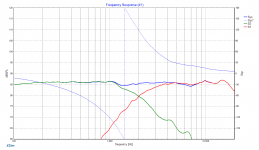As the title says, I'm looking to convert my passive Mk1 Indexes (Kef B200 version) to active. I can find the area of the B200 but not the Tonegen/Foster derived tweeter to get an idea? Anyone know? Thanks in advance
Use the crossover frequency for other (like) speakers. Also use a protection cap with tweeter when bi-amping.
Linn Index
Linn Index
To convert them, first measure the response at the speaker terminals with the current crossover.
I assume you mean with a scope. Sadly only armed with a multimeter.
Use the crossover frequency for other (like) speakers. Also use a protection cap with tweeter when bi-amping.
Linn Index
Ok. I am trying to go the easier route first, should someone have it.
A multimeter and a pencil will do it if that's all you have. Can you use your computer? Your new crossover would sound worse if you don't have a plan of some sort.
The easiest (equipment-wise) plan would be to make the cross high, then lower it slowly and listen for good and bad. It will be rather challenging because the slopes will not line up because the drivers don't line up, and this changes with frequency so it's difficult to tell which problem you are listening to.
The easiest (equipment-wise) plan would be to make the cross high, then lower it slowly and listen for good and bad. It will be rather challenging because the slopes will not line up because the drivers don't line up, and this changes with frequency so it's difficult to tell which problem you are listening to.
Its a bit more complex for me unfortunately as the crossover point is fixed and only changed by a resistor swap on the board. Can you elaborate re. use of computer please? Apologies but first time in doing this.
A fixed crossover point? I thought you were going to tear out the old crossover, and start with an active one...
Take a look at this plot. It looks like the two responses were split using a simple filter, like an active one, but not the case. They have a different frequency and a different shape. One driver has been made more quiet, and there may also be shaping of the response. This is first part of how there is more to it than a crossover point.
You can use a computer to make plots like these, of your crossover as it is, so you can copy it into active filters.
Take a look at this plot. It looks like the two responses were split using a simple filter, like an active one, but not the case. They have a different frequency and a different shape. One driver has been made more quiet, and there may also be shaping of the response. This is first part of how there is more to it than a crossover point.
You can use a computer to make plots like these, of your crossover as it is, so you can copy it into active filters.
Attachments
"first time in doing this" - this may help: BiAmp (Bi-Amplification - Not Quite Magic, But Close) - Part 1
A fixed crossover point? I thought you were going to tear out the old crossover, and start with an active one...
Well Yes... But not entirely. I plan to able to reinstate the original passive one if needs be, another story. But just sticking to my immediate need, the Active one that I am using has been designed to alter the xo by a simple resistor change.
So follows then that I need to know the point of the original design with a high degree of accuracy. Its a shame as most manufacturers used to give this, but not some. As the Linn tweeter is a commercial one that was been re-tweeked reached a dead end finding the parameters. Hence my question
Last edited:
In that case, take your meter and probe each of the driver terminals separately, while sweeping them slowly and taking note where the slope is, and where the output is down by half.
This actually can be done just fine with a computer with sound card (line/headphone out, line/microphone in) and the app ARTA without license (REW will possibly accommodate this too). All it takes is some shielded cable, connectors to the computer and a few crocodile clamps. And possibly some resistors to lower the signal to the microphone in of the sound card. Plus a soldering iron. How DIY would you like it?To convert them, first measure the response at the speaker terminals with the current crossover.
Ive had a stroke of luck through more digging. It turns out the same Tonegen tweeter is used by Snell in the E/F/J type loudspeakers. Now they crossed them over at 2.3kHz. Reading on some KEF Kit datasheets it appeared Kef used a preference of 3.5kHz on the kits that employed the B200. So narrows the range. I will plumb for 3kHz and go from there. Thanks all.
- Home
- Loudspeakers
- Multi-Way
- Linn Index Crossover Point?
